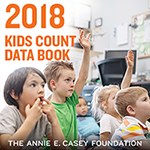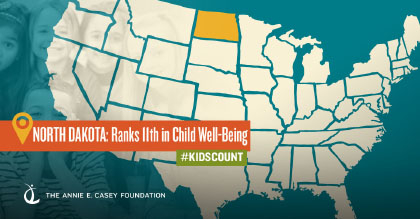Ask A Researcher
July 2018
The 2018 KIDS COUNT® Data Book reveals strengths and challenges for children in North Dakota – and emphasizes that an inaccurate census in 2020 threatens to worsen existing challenges for North Dakota youth

Karen Olson is the program director for North Dakota KIDS COUNT, a program sponsored by the Annie E. Casey Foundation and housed in the Center for Social Research at North Dakota State University. KIDS COUNT® recently released the 2018 KIDS COUNT® Data Book, an annual assessment of children’s well-being in the United States. In this article, Karen offers some insight into the 2018 Data Book, and how North Dakota ranks in regards to the well-being of children and youth.
Last week the Annie E. Casey Foundation released the 2018 KIDS COUNT® Data Book in which North Dakota ranked 11th in the nation for overall child well-being. Although North Dakota ranks well in economic, family, and community indicators, several challenges exist with respect to education and health that could harm children if there is an undercount in the 2020 Census.
The annual Data Book uses 16 indicators to rank each state across four domains —economic well-being, family and community, education and health — that represent what children need most to thrive. In the 2018 Data Book, North Dakota ranks:
- 1st in Economic Well-Being. North Dakota continues to lead the nation in the economic well-being of children. Among states, North Dakota has the lowest percentage of children in families with a high housing cost burden (paying 30 percent or more of their income toward housing) (19 percent); the fifth lowest percentage of children without secure parental employment (22 percent); the fifth lowest child poverty rate (12 percent); and the fifth lowest percentage of teens not attending school and not working (5 percent).
- 4th in the Family and Community domain. When compared with other states, children in North Dakota fare well in terms of family and community indicators. Six percent of North Dakota children live in families where the head of household lacks a high school diploma and 26 percent of children live in a single-parent family. The national averages are 14 percent and 35 percent, respectively. In addition, North Dakota saw declines in the teen birth rate and in the percentage of children living in high-poverty neighborhoods.
- 31st in Education. Despite a minor improvement in the on-time high school graduation rate, two-thirds of fourth-graders are not proficient in reading, 60 percent of eighth-graders are not proficient in math and 68 percent of North Dakota three- and four-year olds are not enrolled in prekindergarten programs.
- 32nd in Health. North Dakota saw a slight improvement in the percentage of babies born with a low birth weight and the child and teen death rate dropped to 23 per 100,000 (a rate lower than the national average). However, the uninsured rate for children in North Dakota has risen to 8 percent since 2010 and remains twice the national average. About 5 percent of teens abused alcohol or drugs in the past year.
These data provide us an opportunity to better understand the opportunities and challenges facing children and families in our state and to strategically invest in their futures. The above results are based on data from a variety of data sources, one of which is the U.S. Census Bureau. As we are getting closer to 2020, it is important to understand that making sure we know how many children we have in North Dakota — having an accurate count in the 2020 Census — is critical to ensuring that we have the resources necessary to address those challenges and opportunities.
Unfortunately, children under age five are historically one of the most difficult age groups to count in the census. Those most likely to be missed tend to live in hard-to-count areas with high poverty rates, lower educational attainment, high unemployment, high mobility, temporary or unconventional housing arrangements, language barriers, and a distrust of outsiders. In North Dakota, approximately 4,000 young children live in these hard-to-count areas, which is nearly 8 percent of all young children in the state.
When children aren’t counted, state and local infrastructures face losing millions of federal dollars. Much of the federal funding allocated to North Dakota relies on census-derived data for distribution. Census-derived data are used to distribute more than $1.45 billion a year to North Dakota, including $331 million directly to children for programs covering health (Medicaid, State Children’s Health Insurance Program), education (Title I, Head Start, Special Education), food security (Supplemental Nutrition Assistance Program, National School Lunch Program, and WIC), foster care and child care.
With the challenges our state is facing, it is critical to have an accurate census in 2020, specifically an accurate count of children in North Dakota. We count on our children to build North Dakota’s future and therefore we must count all children in 2020 so we can direct funding to meet their needs.

